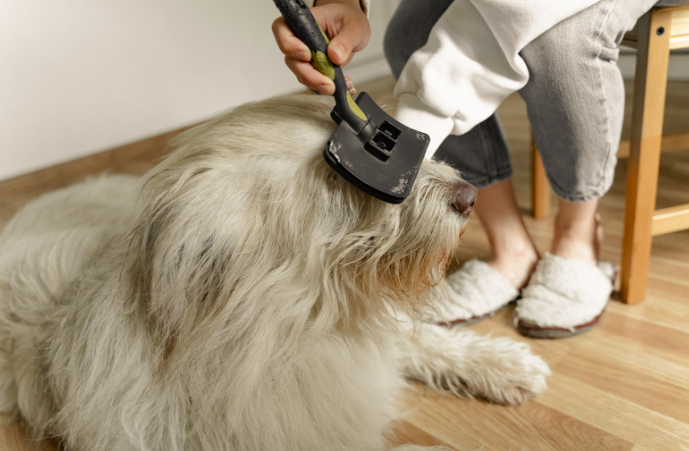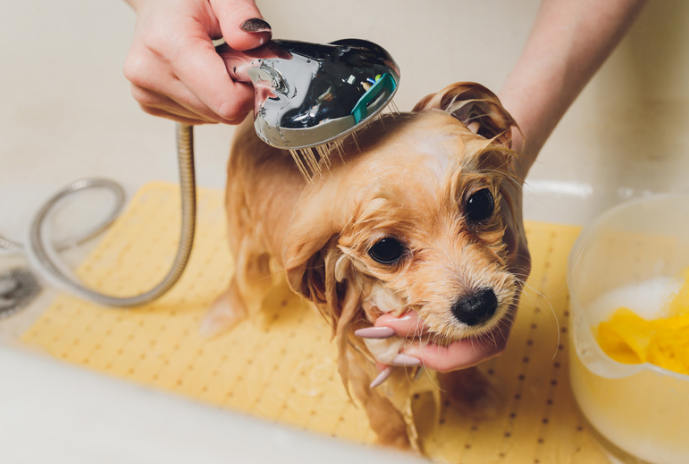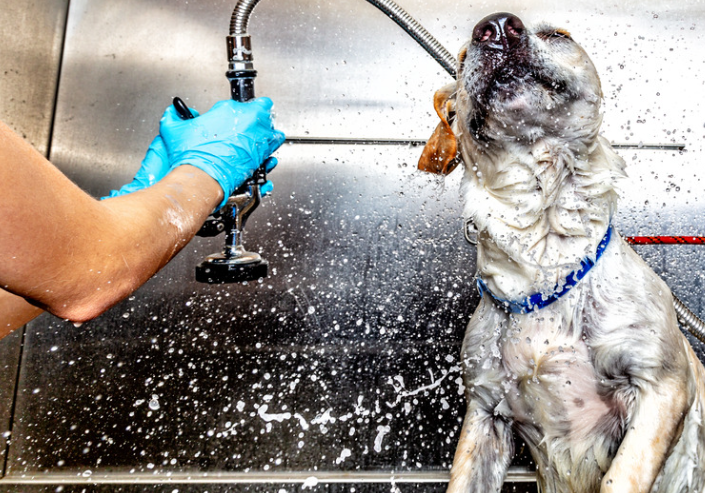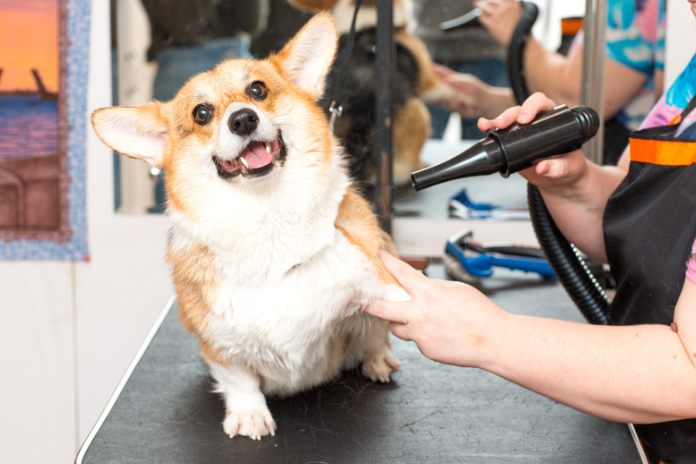You should know dirty coats and poor sanitation in dogs can lead to bacterial or fungal infections, often resulting in recurring diseases like Yeast Dermatitis, Staphylococcal Infection, and Blastomycosis.
Therefore, bathing becomes a must to keep your canine clean and healthy, but do you know how to bathe them properly?
You can properly bathe your dog, starting with brushing your dog’s fur, moistening the coat, shampooing, rinsing, and drying the skin to cleanse and remove infections and pests effectively.
Here is a detailed guide to giving your dog a proper bath.

How Frequently Your Dog Needs Bathing
The average bathing frequency of dogs is once a month. However, some may need more frequent baths, such as those with skin allergies or long, thick coats.
The frequency of bathing your dog depends on its breed, coat type, lifestyle, and overall health.
Ensure not to over-bathe them because it can cause dry, itchy skin while under-bathing leads to skin infections.
Signs That Your Dog Needs Bath
- Dirty fur with tangles and mats
- Excessive shedding
- Oily and greasy coat
- Scratches or biting
- Regularly plays outside in dust or contacts other animals.
- Stained paws and other body parts.
Therefore, it will help if you monitor your dog’s skin and coat health and adjust their bathing schedule.
Moreover, you can also consult with your veterinarian to determine the best bathing schedule for your dog based on their habits.
Proper Bathing Tips for Your Dog
Regular bathing removes dead skin cells, which can accumulate on the skin and coat and lead to odor, itching, and other problems.
It also helps prevent parasite infestations, such as fleas and ticks and removes dirt and debris that can cause discomfort or skin irritation.
Here are the essential techniques to properly bathe your dog.
1. Brush the fur
Dog fur can trap dirt, debris, and moisture, leading to skin irritation and hot spots. Also, the tangled hair can trap shampoo and water, making it harder to clean properly.
So, brushing before the bath helps remove loose hair, mats, or knots and makes bathing easier.

Here is how to properly brush your dog
- Start with a gentle touch to make your dog feel secure.
- Use treats to make the task fun.
- Use positive reinforcement to make it a habit for your dog.
- Give your dog a chance to relax and get used to the process.
- Brush in the direction of hair growth.
Things to Consider While Brushing
- Choose the right brush appropriate for your dog’s coat, such as a slicker brush for long-haired and a bristle brush for short-haired.
- Work in small sections and be patient while breaking tangles and mats.
- Pay attention to sensitive areas such as ears, paws, and bellies.
- Check for fleas and ticks before brushing if your dog shows lethargy, bald spots, scratches against the furniture, and appears irritated.
- Using a flea comb will be best if they have parasites like fleas.
- Use a detangler spray before loosening tangles.
2. Moisten the Coat
Wetting your dog prior to bathing is crucial as it opens up hair follicles, prevents skin irritation, and helps distribute the shampoo evenly.
It also saves the skin from the adverse effects of shampoo and prevents it from drying.
However, you should ensure the wetting process is a positive and safe experience for your furry friend.

Things to consider while wetting your dog
- Use lukewarm water, not too hot or cold.
- Use a handheld gentle sprayer to control water pressure and wet target areas.
- Start from the back and slowly move towards its head.
- Use treats or praise to build confidence if your dog is anxious or fearful of water.
- Protect your dog’s ears by using cotton balls or earplugs.
3. Shampooing
Shampooing helps remove odors trapped in the dog’s coat, leaving your dog smelling fresh and clean.
However, human shampoo may be too harsh for your dog’s delicate skin, which could result in dryness or irritation.
That is why you should employ a soft, canine-specific shampoo free from abrasive ingredients or strong scents.
- Choose a dog-specific shampoo to avoid skin irritation from mild pH levels.
- Avoid harsh chemicals like parabens, sulfates, and artificial fragrances.
- Look for ingredients suited to your dog’s needs. For example, choose hypoallergenic shampoo if your dog has sensitive skin.
- Select a shampoo based on your dog’s coat type. For example, Earthbath oatmeal and aloe shampoo suit thick and double coats, and Burt’s Bees suits short and smooth fur.
- Consult with a vet if your dog has a skin condition or allergy.

Proper Shampoo Applying Technique
- Step 1: First, dilute the shampoo with water before applying it to your dog’s coat.
- Step 2: Add shampoo to a water bowl or dispenser containing water for dilution.
- Step 3: Create foam to soften the concentration.
- Step-4: Wet your dog’s coat thoroughly with warm water before applying shampoo.
- Step-5: Apply the shampoo starting at the neck and working your way down.
- Step-6: Massage the shampoo thoroughly, paying particular attention to dirt-prone areas such as the belly, armpits, and feet.
- Step-7: Rinse your dog thoroughly with warm water, ensuring all shampoo is removed.
4. Rinse Thoroughly
Rinsing your pet after a bath is essential for ensuring their skin and coat stay healthy and comfortable and preventing potential health issues.
If the shampoo is not rinsed properly, it can cause skin irritation, dryness, and itching.
Moreover, leftover shampoo residue can make your dog’s coat look dull and greasy, causing fatal gastrointestinal problems if your dog ingests it while grooming later.

Why Rinsing Your Pet after a Bath is Necessary?
- It helps to remove shampoo properly.
- It protects from itching and irritation.
- It helps to prevent the dog’s skin from being dry and flaky.
- Rinsing helps to make your pet’s coat healthy.
- It helps to remove traces of dirt, debris, and loose fur.
- It helps to prevent the ingestion of chemicals when your dog grooms itself later.
5. Dry Properly
Drying the fur after bathing is necessary for dogs to prevent a range of potential health issues.
When left wet, a dog’s fur can become a breeding ground for bacteria, fleas, ticks, and other parasites, leading to skin infections and unpleasant odors.
Moreover, moisture trapped in the fur can also cause tangles which can be painful for your dog.
Wet fur also weakens the immune system and makes dogs more susceptible to illnesses.
Therefore, drying your dog’s fur after bathing is essential for maintaining its health and well-being. It helps to prevent skin infections, matting, and unpleasant odors and keeps your dog comfortable and happy.

How Can You Dry Your Dog Properly?
- If your dog has short fur, use a clean towel to remove as much water as possible from your dog’s coat.
- Squeeze and pat gently. Do not rub too harshly because it can cause matting or tangling.
- If your dog has a thick coat, use a low-heat setting hair dryer, and hold it 6 inches from your dog’s skin.
- Avoid using high heat or directing it too close to their face or ears when drying.
- After your dog is completely dry, gently brush its fur to remove any tangles or mats that may have formed while drying.
- Check your dog’s ears for any excess moisture.
- Use a clean, dry cotton ball to gently remove any water and prevent the risk of ear infections.
Conclusion
Proper bathing practices can be a fun and bonding experience for you and your pup.
Moreover, you can maintain their overall hygiene and prevent illnesses caused by poor sanitation by brushing their fur, shampooing, rinsing, and drying thoroughly.
However, remember to monitor your dog’s skin and coat health and adjust their bathing schedule accordingly.
By doing so, you can keep your furry friend clean and healthy for years to come.
Contact our certified veterinarian to determine your dog’s coat type and suitable shampoo. Moreover, if your pet shows symptoms of distress due to infection or allergy, contact the best pet hospital in Urbandale, Urban Pet Hospital, immediately.